Log(1 x) maclaurin series 185773-The expansion of the function log(1-x) in maclaurin series is equal to
Notebook Groups Cheat Sheets;Get access to the complete Calculus 2 course Get started Learn math Krista King November 25, math, learn online, online course, online math, calculus 2, calculus ii, calc 2, calc ii, maclaurin series, radiusGet the free "Log(1x) Taylor Series" widget for your website, blog, Wordpress, Blogger, or iGoogle Find more Mathematics widgets in WolframAlpha

Taylor Series Numerical Methods Projects
The expansion of the function log(1-x) in maclaurin series is equal to
The expansion of the function log(1-x) in maclaurin series is equal to-The Maclaurin series for ln x does not exist because the derivative of ln x is 1/x and therefore f(0) = 1/0, which is undefined All the derivatives will be undefined in this way because you would be dividing by zero If you really need Maclaurin to express natural logs, then you have to shift the curve by 1 to the left Hence you can have a Maclaurin series for ln(1x) instead Another optionSince the series converges at both endpoints of the interval, the interval of convergence of the Maclaurin series of ???f(x)=\ln(12x)???


Expand Log X In Powers Of X 1 By Taylor S Series Sarthaks Econnect Largest Online Education Community
(x x 0)n (1) converge (usually the Root or Ratio test helps us out with thisTo get `tan(x)sec^3(x)`, use parentheses tan(x)sec^3(x) From the table below, you can notice that sech is not supported, but you can still enter it using the identity `sech(x)=1/cosh(x)` If you get an error, doublecheck your expression, add parentheses and multiplication signs where needed, and consult the table belowWrite down the Taylor series expansion, of the function log x about x = 1 upto three nonzero terms for x > 0 asked Aug 25, in Applications of Differential Calculus by Aryan01 ( 501k points) applications of differential calculus
25/09/11 · If any of the bounds do no longer exist, then the expression has no MacLaurin series this timehonored one ought to have a MacLaurin series with a radius of convergence of pi, if I undergo in strategies properly the 2nd would not have a MacLaurin series because of the fact the cut back as x>0 of two/sin(x) would not exist inspite of the shown fact that, the 2nd does have a Taylor seriesFree Taylor/Maclaurin Series calculator Find the Taylor/Maclaurin series representation of functions stepbystep This website uses cookies to ensure you get the best experience By using this website, you agree to our Cookie Policy Learn more Accept Solutions Graphing Practice;Answer Stepbystep explanation By chain rule, we have We need to evaluate the derivatives in zero in order to get the maclaurin series Once sec(0) = 1 and tan(0) =0, we have
What is the expansion of log(1x)?Stack Exchange network consists of 176 Q&A communities including Stack Overflow, the largest, most trusted online community for developers to learn, share their knowledge, and build their careers Visit Stack ExchangeThough, the computation of an infinite sum which give the value of a function in terms of the derivatives evaluated at a special case where x0 = 0,in contrast with Taylor series The Maclaurin's series for ln(1x) could be used to approximate the natural logarithm ln(x)



9 Maclaurin S Theorem Problem 1 Differential Calculus Youtube



Maclaurin Series For Ln 1 X How To Steps Video Lesson Transcript Study Com
19/06/17 · 1/(1x) = sum_(k=0)^oo x^k Given f(x) = 1/(1x) It seems to me that the easiest way to find the Maclaurin Series is basically to start to write down the multiplier for (1x) that results in a value of 1 Write down 1 = (1x)( The first term of the multiplier will be 1, in order to get 1 when multiplied, so add that to the right hand side 1 = (1x)(1Expand log (1 e x) in ascending powers of x up to the term containing x 4 differential calculus;G 2 Big Questions 3 For what values of x does the power (aka Taylor) series P 1(x) = X1 n=0 f(n)(x 0) n!



What Is The General Term For E X 1 X Mathematics Stack Exchange
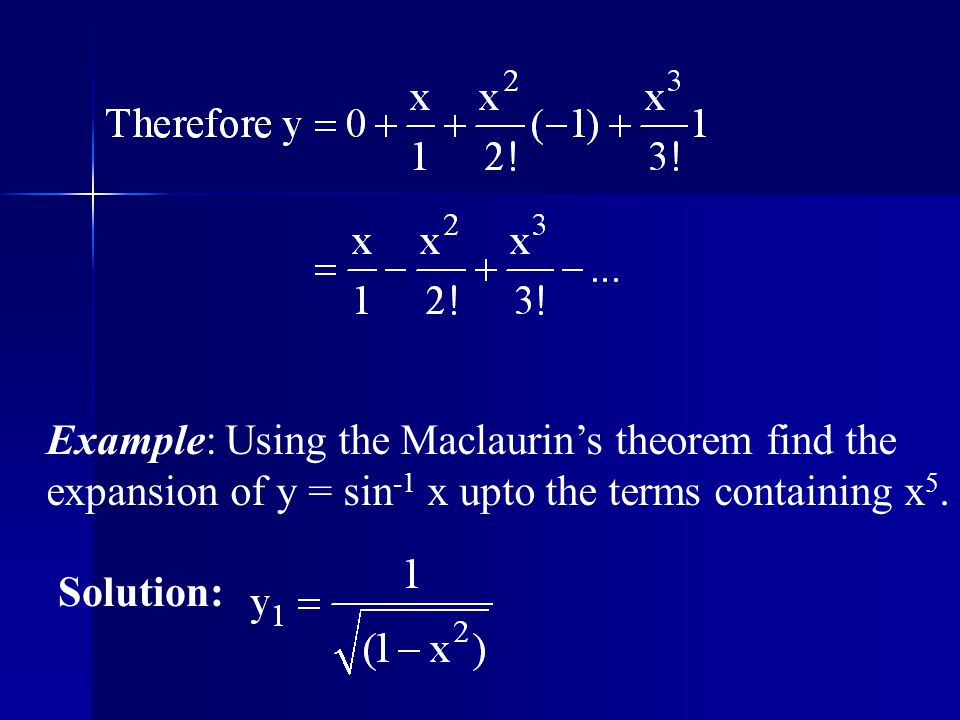


Example Obtain The Maclaurin S Expansion For Ppt Video Online Download
By integrating the above Maclaurin series we find the Maclaurin series for log(1 − x), where log denotes the natural logarithm and the corresponding Taylor series for log(x) at a = 1 is and more generally, the corresponding Taylor series for log(x) at some is The Taylor series for the exponential function ex at a = 0 is The above expansion holds because the derivative of e xwithShare It On Facebook Twitter Email 1 Answer 0 votes answered May 7, 19 by Nakul (701k points) selected May 7, 19 by Vikash Kumar Best answer Let y = log (1 e x), y(0) = log2 Therefore from Maclaurin's theorem, we get ← Prev Question Next Question → RelatedThe procedure to use the Maclaurin series calculator is as follows Step 1 Enter two


Write The Maclaurin Series Expansion Of The Following Functions I E X Ii Sin X Iii Cos X Iv Log 1 X 1 X 1 Sarthaks Econnect Largest Online Education Community



Math Review With Matlab Calculus Taylors Series S
En résumé, alors que les 3 premières séries de MacLaurin, \(\mathbf{sin~}x, \mathbf{cos~}x, \mathbf{exp~}x\), convergent pour toutes les valeurs de \(x\), la dernière, celle de \(\mathbf{ln~}(1x)\), converge uniquement lorsque \(x \in 1, 1\) L'intervalle de convergence, s'il est centré, porte le nom de "rayon de convergence" Dans les cas étudiés plus haut, le "rayonMaclaurin Series for ln (1x) Deriving the Maclaurin expansion series for ln (1x) is very easy, as you just need to find the derivatives and plug them into the general formula As you can see ln1 = 0 Once you differentiate, you end up with a simple reciprocal23/08/17 · f(x) = 1 1/2x 1/8x^2 1/16x^3 5/128x^4 Let f(x) = sqrt(1x) We seek a Taylor Series, as no pivot is supplied, it is assumed that an expansion about the pivot x=0 is required This is known as a Maclaurin series and is given by f(x) = f(0) (f'(0))/(1!)x (f''(0))/(2!)x^2 (f'''(0))/(3!)x^3 (f^((n))(0))/(n!)x^n Although we could use this method, it is actually
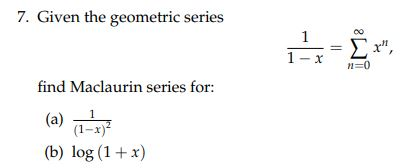


Solved 7 Given The Geometric Series Find Maclaurin Serie Chegg Com


Taylor Series
In this lesson, we show how to find the Maclaurin series for a particular function ln(1 x) In addition to the steps for finding this series, you will also learn how to determine its region ofA Maclaurin series is a function that has expansion series that gives the sum of derivatives of that function The Maclaurin series of a function up to order n may be found using Series It is a special case of Taylor series when x = 0 The Maclaurin series is given byLet f(x)=log(1x) The Maclaurin expansion is f(x)=f(0) xf'(0) (x²/2!)f''(0) f(0)=log(10)=log(1)=0 f'(x)=Dlog(1x) f'(x)=1/(1x) f'(0)=1/(10)=1 f''(x)=1



Expand Logex In Power Of X And Hence Evaluate Loge 1 1 Correct To Four Decimal Places Answer Mathematics 1 Question Answer Collection
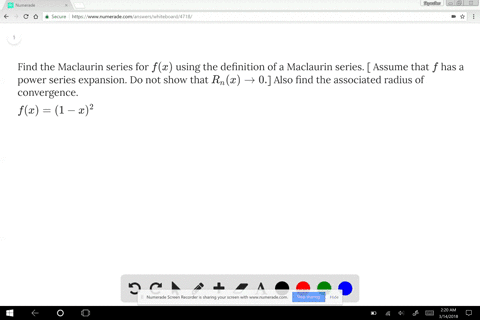


Solved Find The Maclaurin Series Of F By Any Met
Ad by The Penny Hoarder 9 lessons from millionaires who are good with money Life would be a whole lot easier if someone would just Venmo us $1 million Read More 16 Answers Quora User Answered 2 years ago · Upvoted by Aiswarya Priya, studied Mathematics & 2 Biomaths at StCatherines HSS Wayanad 814K views · View upvotes · View14/01/18 · Convergent when x 1For the Maclaurin series of $(1x)\ln(1x)$ I have obtained $$\sum^\infty_{k=1}\frac{x^{k1}}{k}\sum^\infty_{k=1}\frac{x^k}{k}$$ I am unsure on how to use this to obtain the value of the sum $$ Stack Exchange Network Stack Exchange network consists of 176 Q&A communities including Stack Overflow, the largest, most trusted online community for developers to learn, share their
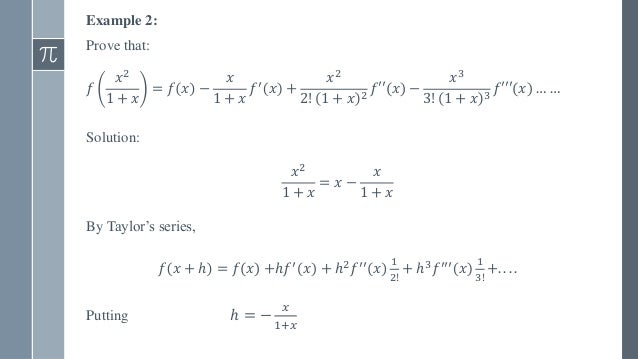


Power Series Taylor S And Maclaurin S Series


Expand Log 1 X Y Up To Third Degree Terms About The Origin Sarthaks Econnect Largest Online Education Community
The problem here is that Taylor series doesn't converge for any number larger than 2, in other words Taylor series for ln(1x) doesn't converge for x > 1 You can find actual radius of convergence with ratio test The formula isThe Maclaurin series for y = f(x) is just the Taylor series for y = f(x) at x 0 = 0 1Here we are assuming that the derivatives y = f(n)(x) exist for each x in the interval I and for each n 2N f1;2;3;4;5;This video includes Maclaurin's series for log(1x), log(1x), (1x)^m in Calculus subject by Learn with vms 1) log(1x) 2) log(1x) 3) (1x)^m



Taylor Series Wikipedia


How To Expand Log 1 Log 1 X In Powers Of X As Far As X 4 Quora
15/01/17 · (sinx)/x = sum_(n=0)^oo (1)^n x^(2n)/((2n1)!) Consider the MacLaurin series for sinx sinx = sum_(n=0)^oo (1)^n x^(2n1)/((2n1)!) and divide by x term by termSince this series is really similar to the series we're given in this problem, we want to try to manipulate our series until it matches the form of this standard series Manipulate the common series one step at a timeExpand log (1 sinx) up to the term containing x^4 by using Maclaurin's theorem asked May 7, 19 in Mathematics by AmreshRoy ( 694k points) differential calculus



Using Maclaurin Series Prove Log 1 E X Log X 2 X 2 8 X 4 192 Brainly In
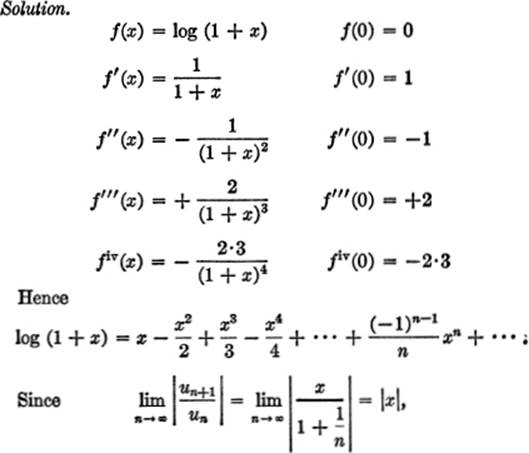


70以上 Log1 X Taylor Series Expansion
From a table of standard Maclaurin series, we already know that the sum of the Maclaurin series of ???\cos{x}???14/07/16 · To find a Maclaurin series for #ln((1x)/(1x))# from scratch, we first need to take note of expressing a function as an infinite sum centered at #x= 0# In order to do this, we write #f(x) = # #f(0) f^(1)(0)/(1!)x f^(2)(0)/(2!)x^2 f^(3)(0)/(3!)x^3 = sum_(n=0)^(∞) f^(n)(0) x^(n) / (n!)# This infinite sum suggests that we'd have to calculate some derivatives, which I willA Maclaurin series can be used to approximate a function, find the antiderivative of a complicated function, or compute an otherwise uncomputable sum Partial sums of a Maclaurin series provide polynomial approximations for the function A Maclaurin series is a special case of a Taylor series, obtained by setting x 0 = 0 x_0=0 x 0 = 0



Taylor Series Wikipedia


2 The Maclaurin Series To Calculate The Natural Logarithm Of 1 X Is Defined As Follows Write A Matlab Script That First Asks The User To Input A Course Hero
02/01/17 · Taking the derivative of the MacLaurin series gives you $1 x x^2 x^3 x^4 \ldots$ Since this is a geometric series with ratio $x$, it equals $\frac{1}{1 x}$ when x is in $(1, 1)$ This shows the expression $\ln(1x)$ and its MacLaurin expansion to have the same derivative over $(1, 1)$, which means they are equal within a constantMaclaurin Series Calculator is a free online tool that displays the expansion series for the given function BYJU'S online Maclaurin series calculator tool makes the calculation faster, and it displays the expanded series in a fraction of seconds How to Use the Maclaurin Series Calculator?Taylor and Maclaurin Series If we represent some function f(x) as a power series in (xa), then 3 Uniqueness Theorem Suppose for every x in some interval around a Then 4 Taylor's Formula with Remainder Let f(x) be a function such that f(n1)(x) exists for all x on an open interval containing a Then, for every x in the interval, where R n(x) is the remainder (or error) Taylor's Theorem



Maclaurin Series For Ln 1 X How To Steps Video Lesson Transcript Study Com



Logarithms Logs Log Ln Lg


Find The Taylor Polynomial Of Log 1 X 1 X 1 2 Stumbling Robot



B Expand Y Log 1 Sinx By Maclaurin S Theorem
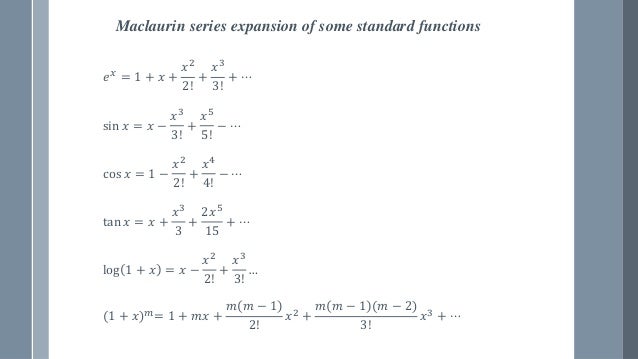


Power Series Taylor S And Maclaurin S Series



Taylor Series For Ln 1 X How To Steps Math Class 21 Video Study Com
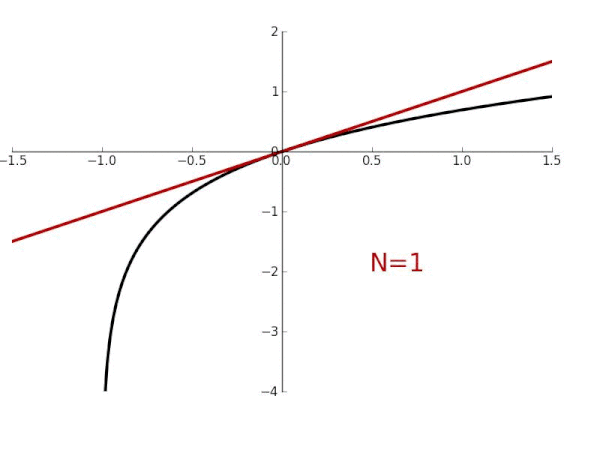


Taylor Series Wikiwand



Natural Log Expansion Page 1 Line 17qq Com



Taylor Series Expansion Of Natural Log Function Youtube


Maclaurin And Taylor Series Power Series Expansion Of Logarithmic Function
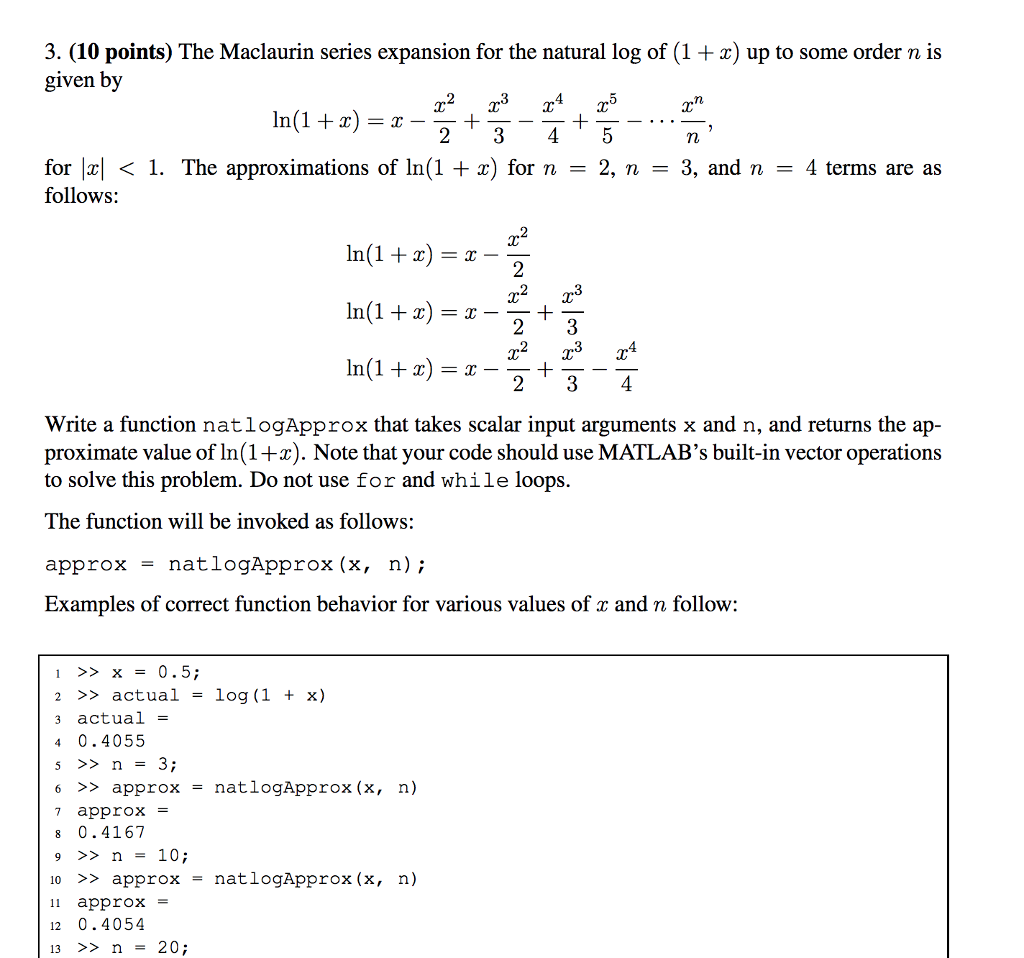


Solved The Maclaurin Series Expansion For The Natural Log Chegg Com



Taylor Series Wikipedia



Taylor Series Numerical Methods Projects



Taylor Expansion Of Log X Page 1 Line 17qq Com



Expand 1 Dim Vector By Using Taylor Series Of Log 1 E X In Python Stack Overflow


Natural Logarithm Series


Expand Log 1 Sinx Up To The Term Containing X 4 By Using Maclaurin S Theorem Sarthaks Econnect Largest Online Education Community
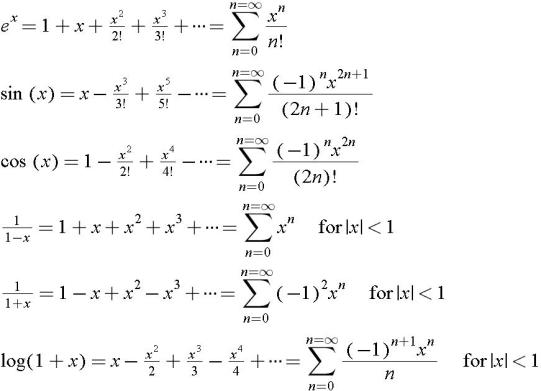


Appendix C Expansions Differentiation Integrals And Mathematical Relations Engineering360



What Is The Correct Radius Of Convergence For Ln 1 X Mathematics Stack Exchange


How To Use The Maclaurin S Series To Estimate The Value Of Ln 0 9 To 8dp Quora
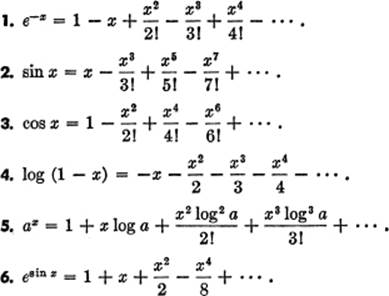


Expansion Of Functions Expansion Of Functions The Calculus Primer



Solved A Find The Maclaurin Series For 1 X Log 1 Chegg Com


Expand Log X In Powers Of X 1 By Taylor S Series Sarthaks Econnect Largest Online Education Community



Maclaurin S Series For Log 1 Tan X Mathematics Stack Exchange
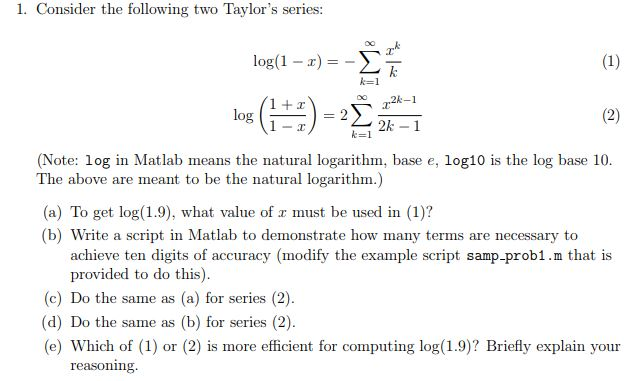


Solved 1 Consider Following Two Taylor S Series Log 1 X K 1 2k 1 Note Log Matlab Means Natural Lo Q



Expand Log 1 X In Powers Of X Then Find Series For And He Scholr


Natural Logarithm Series



Worked Example Recognizing Function From Taylor Series Video Khan Academy


Write Down The Taylor Series Expansion Of The Function Log X About X 1 Upto Three Non Zero Terms For X 0 Sarthaks Econnect Largest Online Education Community



Maclaurin Series For Ln 1 X How To Steps Video Lesson Transcript Study Com



Natural Logarithm Wikipedia


What Is The Expansion Of Log 1 X Quora



How To Expand Logcosx Using Expansion Of Log 1 X And Cos X Quora


Taylor Series For Log X Physics Forums
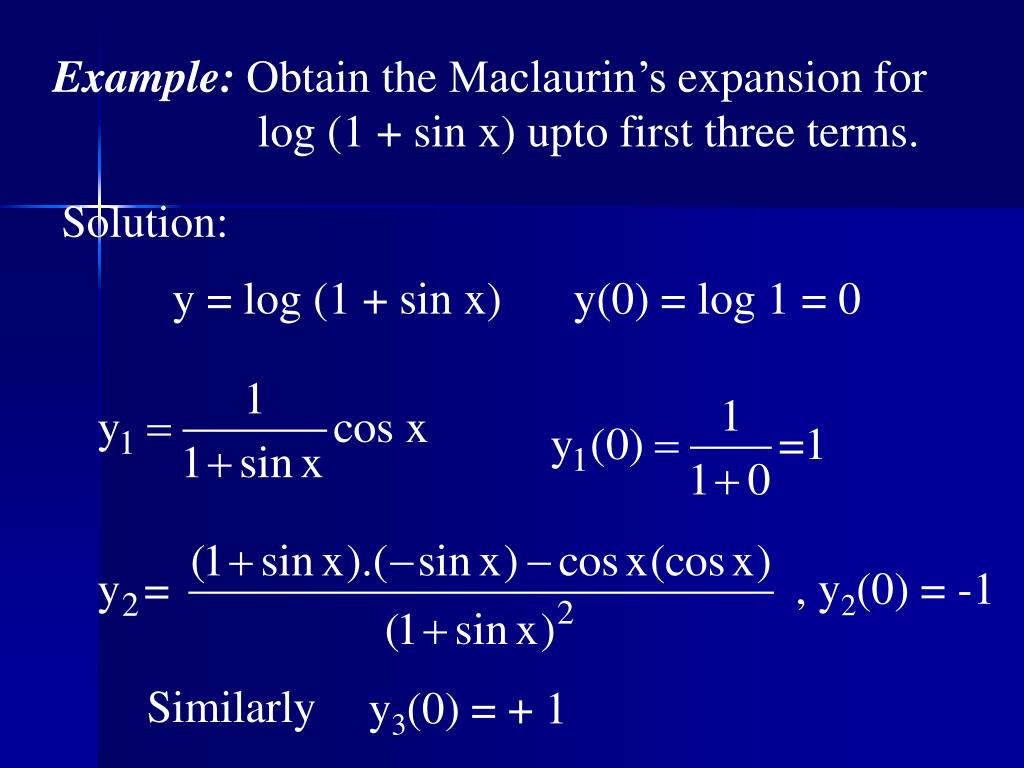


Ppt Example Obtain The Maclaurin S Expansion For Powerpoint Presentation Id


Taylor And Maclaurin Series



F A X 4 Expand The Following Functions In A Maclaurin Series 2 1 X B 1 Homeworklib



Expansion Of Log 1 X Maclaurin Series Youtube


How Do You Find The Maclaurin Series For F X Ln Cosx Socratic



Expand 1 Dim Vector By Using Taylor Series Of Log 1 E X In Python Stack Overflow


Expand Log 1 E X In Ascending Powers Of X Up To The Term Containing X 4 Sarthaks Econnect Largest Online Education Community



Taylor Series Expansions Of Logarimathic Functions
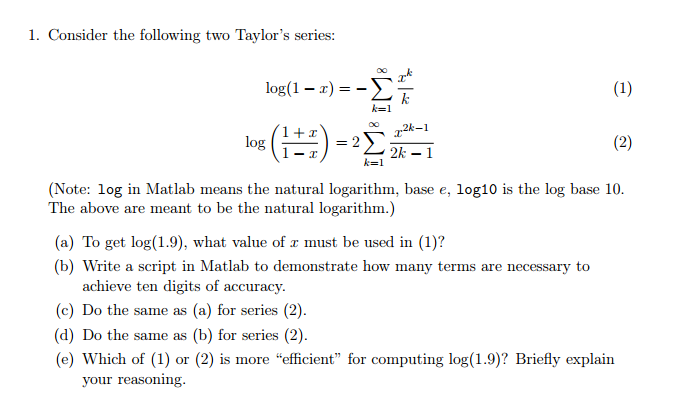


Consider The Following Two Taylor S Series Log 1 Chegg Com


Cochranmath Taylor Series Integration And Differentiation



Maclaurin Series For Ln 1 X Youtube


How Do You Do The Taylor Expansion For F X Log X 1 At X 0 Socratic



Taylors And Maclaurins Series Mathematical Relations Mathematical Concepts


Natural Logarithm



Solved 3 7pts The Taylor Series For F X Log 1 X Chegg Com



Log X Expansion Page 1 Line 17qq Com


Chapter Vi



Expansion Of Log 1 Sinx Youtube



Graphs Of Taylor Polynomials Wolfram Demonstrations Project
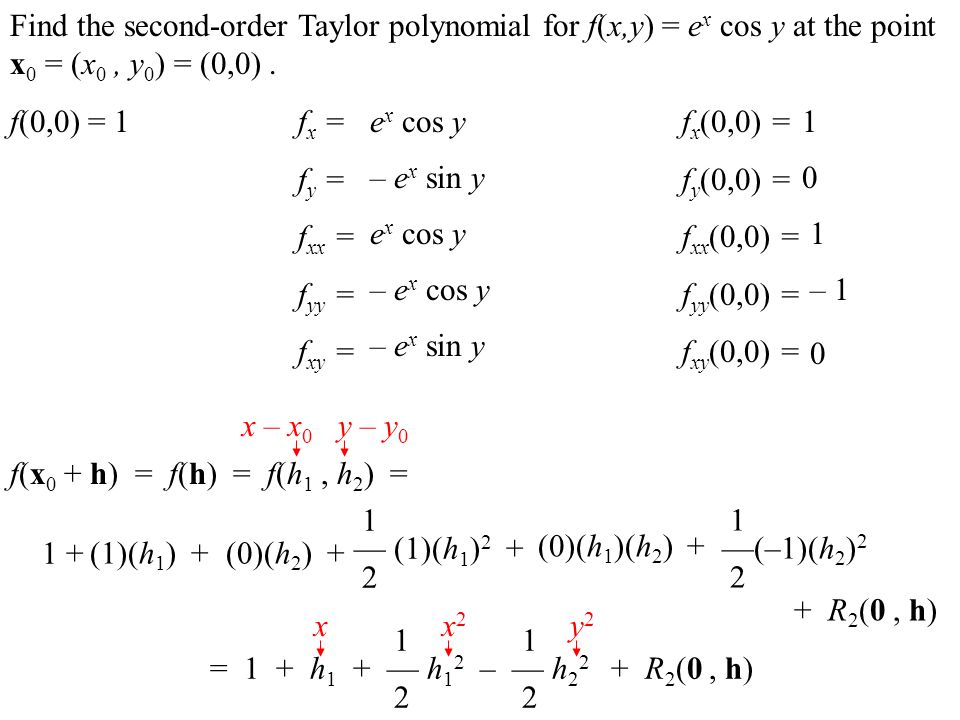


Maclaurin Series Of E Sinx



The Natural Logarithm And Its Series Expansion 2 Ways Ln X 1 At 0 Youtube
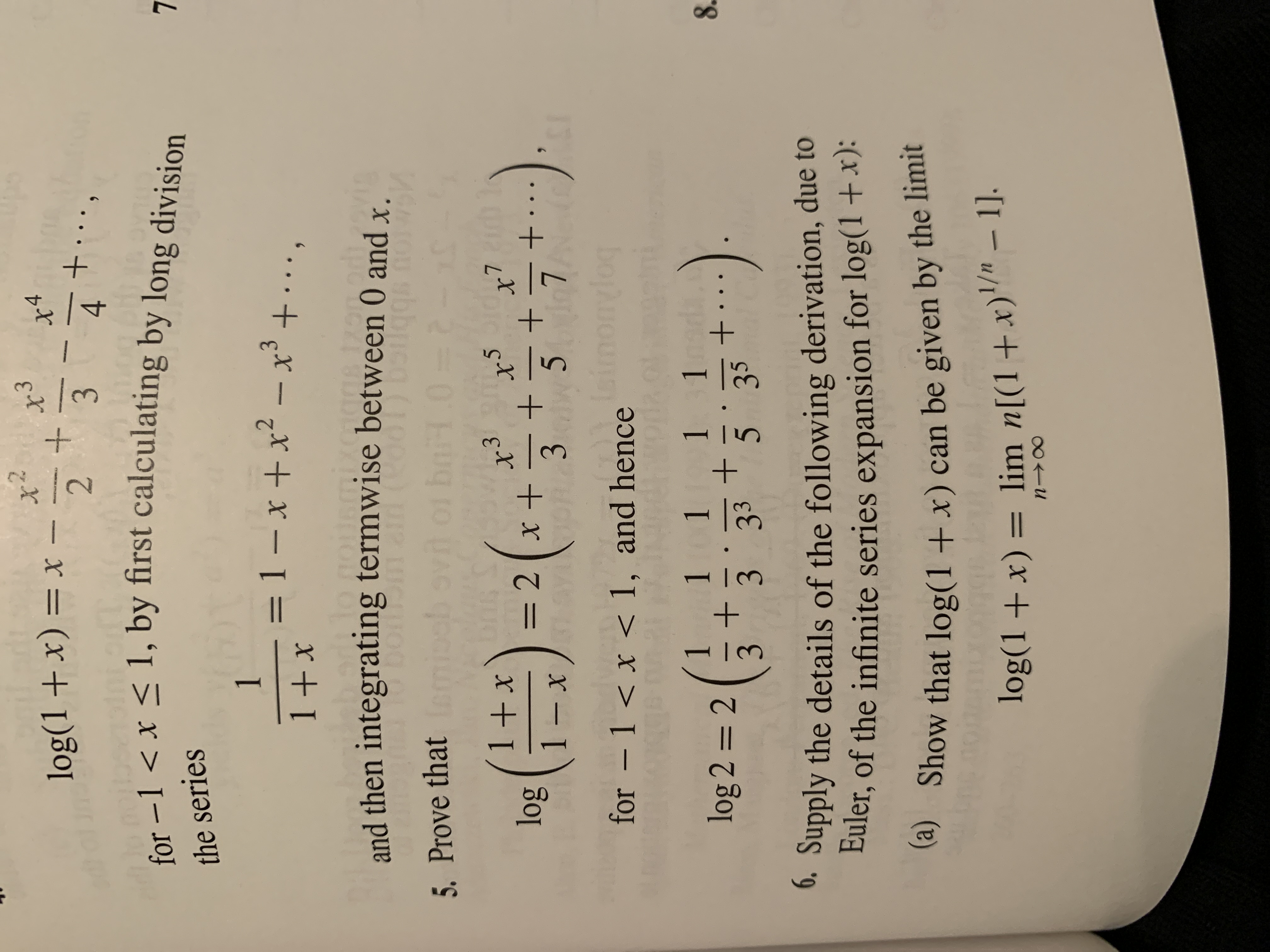


Answered X X3 Log 1 X X 2 3 4 For 1 Bartleby
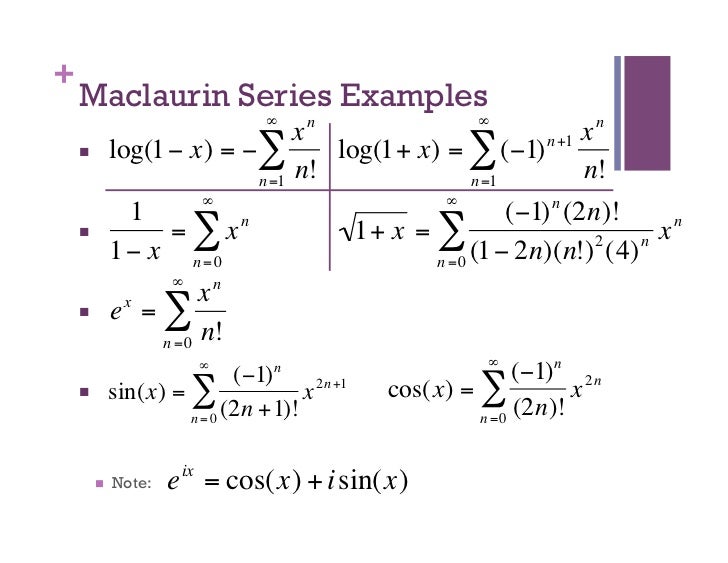


Taylor Series
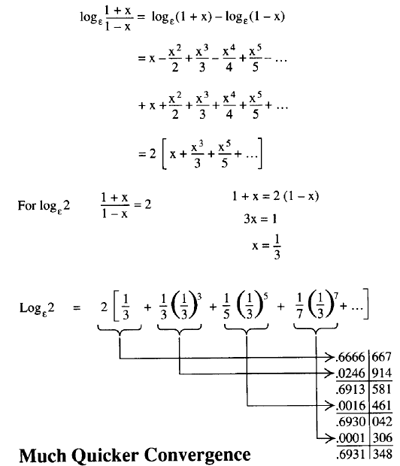


Logarithms Logs Log Ln Lg
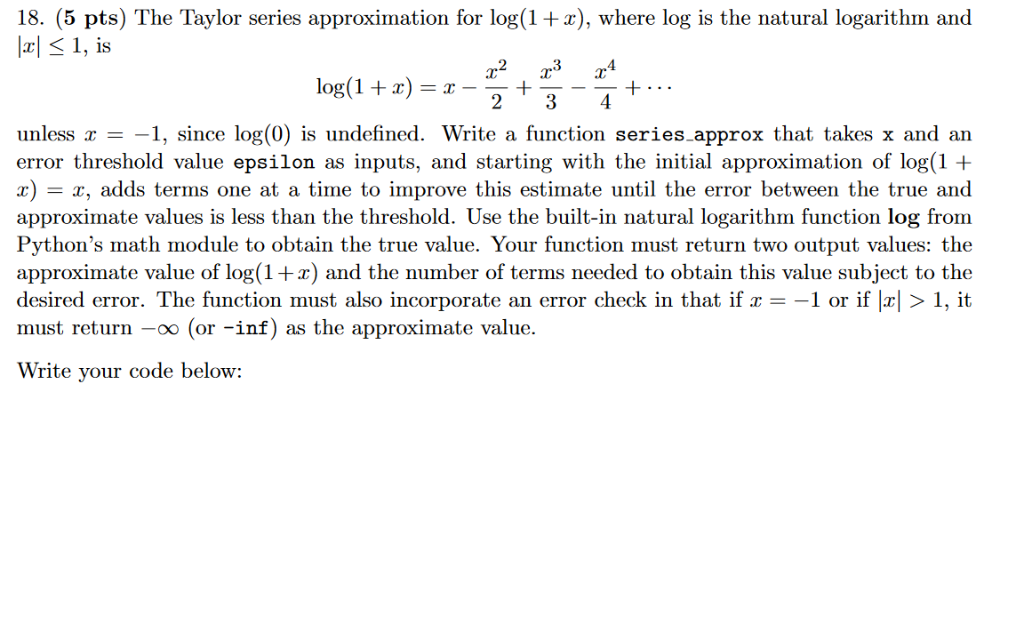


Solved 18 5 Pts Taylor Series Approximation Log 1 X Log Natural Logarithm 3 2 73 4 Log 1 X X Unl Q 1



Log 1 E X Maclaurin Series
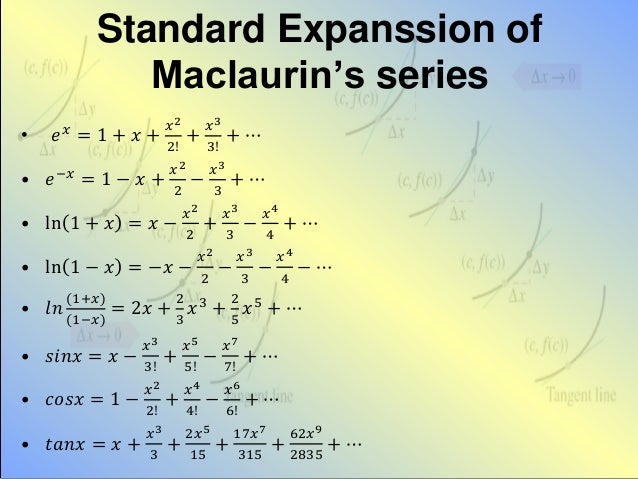


Taylor S Maclaurin S Series Simple



Taylor Series Numerical Methods Projects



Expand The Function F Z Log 1 Z 1 Z In Taylor Series Homeworklib



Taylor Series Wikipedia


Taylor Series For Log X Physics Forums
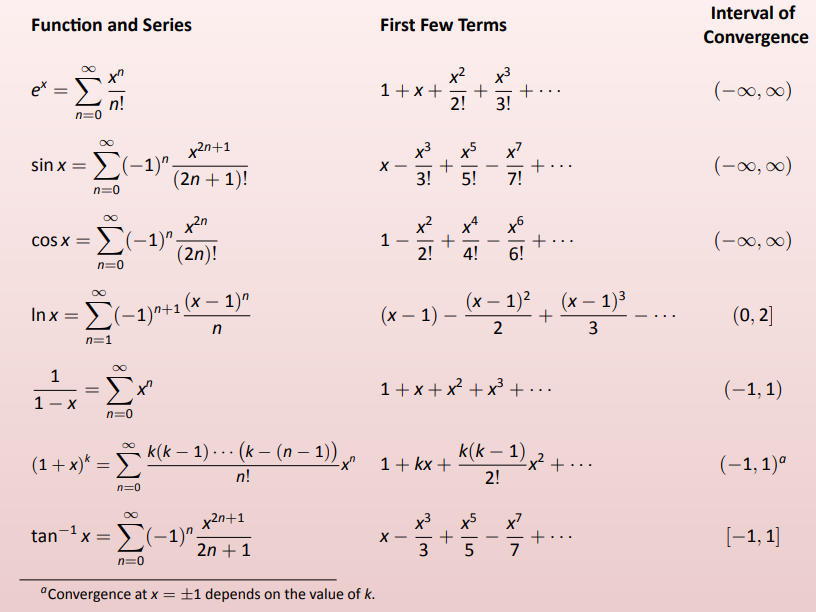


8 8 Taylor Series Mathematics Libretexts



Taylor Series Wikipedia



Help With Arithmetic On Basic Taylor Series Expansion Mathematics Stack Exchange



Expand 1 Dim Vector By Using Taylor Series Of Log 1 E X In Python Stack Overflow



Solved Find The Following Limit Lim X Rightarrow 0 Ln 1 X X X 2 1 Answer Transtutors



Worked Example Recognizing Function From Taylor Series Video Khan Academy


Expand E X Log 1 Y By Maclaurin S Theorem Up To The Third Degree Term Sarthaks Econnect Largest Online Education Community


Maclaurin And Taylor Series Power Series Expansion Of Logarithmic Function



Which Is Dfrac1xdfrac12 Dfrac See How To Solve It At Qanda


コメント
コメントを投稿